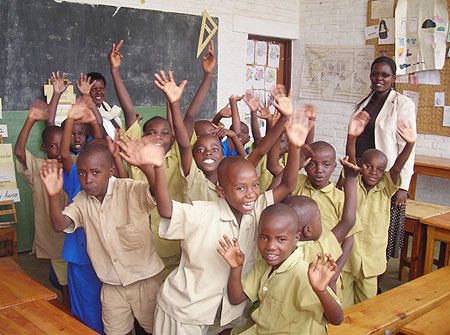To teach the deaf requires more love and patience says Eugenie Baziki, a teacher at Saint Gabriel Centre of the deaf and dumb located in Ngoma Sector, Huye district. In a room filled with ten deaf and dumb children, Madam Baziki does what she has been doing for the last four years—teaching pupils with hearing and speech disabilities how to read and write.


To teach the deaf requires more love and patience says Eugenie Baziki, a teacher at Saint Gabriel Centre of the deaf and dumb located in Ngoma Sector, Huye district.
In a room filled with ten deaf and dumb children, Madam Baziki does what she has been doing for the last four years—teaching pupils with hearing and speech disabilities how to read and write.
There is an unusual communication between teacher and student’s as they use sign language, a practice which Baziki admits is difficult to use in communication especially for young learners.
"These children arrive here when they cannot utter a single word, we tease them into trying to speak so that we can classify them into different levels of understanding,” she said.
In her class, pupils are taught sign language in order to enable them communicate amongst themselves and their teachers.
According to Baziki, despite missing their articulation and hearing senses, pupils at the centre develop a good observation sense. Some have learnt to sharpen their observation senses and in turn impacted their lives and those around them with developed communication skills.
To demonstrate this phenomenon, Jean Damascene Uzabakiriho, a pupil in second level demonstrates to his teacher how he wants to became a soldier after his studies whereas her classmate Rosine Muteteli, demonstrates how she wants to go to University and become a medical doctor. They communicate through sign language while their teacher Baziki interprets.
With four years of experience at Saint Gabriel Centre of the deaf and dumb, Baziki says that teaching at the centre is like teaching toddlers.
"You can’t work here without patience and kindness,” said Baziki.
Jean Marie Vianney Nzahabanayo, a Gabrielite Brother, is the head of the Audiometry Department, a section of the centre that tests the ability of the human ear to detect sounds over a range of frequencies and intensities. He says that teachers are recruited on the basis of their commitment to deal with children with disabilities.
"It is after long observation on how deep a teachers’ love is that we recruit them,” said Brother Nzahabanayo.
He concurs with Baziki that teaching at the centre requires more commitment than an ordinary teaching job.
"Some of our children here can be annoying, it takes patience and love for a professional to teach at the centre,” said Brother Nzahabanayo.
According Baziki, its only patience and kindness that keeps them tied to their work.
"I earn a paltry Rwf26,000 per month a pitiful amount compared to the work that I do, I wish I could earn more,” Baziki said.
According to Brother Nzahabanayo, teachers at the centre deserve additional pay for the sacrificial work and dedication depicted in their work. However, he said that it is unfortunate that the centre’s resources are stretched.
"Our means are limited but we are having consultations with our partners to see how we can motivate them,” he said.
Students trained at the centre are in different categories, some are involved in technical and vocational training while others go through the formal school system and end up at university.
"Students who go through the formal school have gone on to succeed like any other students, some have succeeded even more than those without disabilities,” he said.
The centre was founded by the Brothers of Saint Gabriel and first opened its doors in 1965. It currently has 160 pupils under its care.
Jean Damascene Hakuzimana is a fourth year Journalism and Communication student at the National University of Rwanda.


